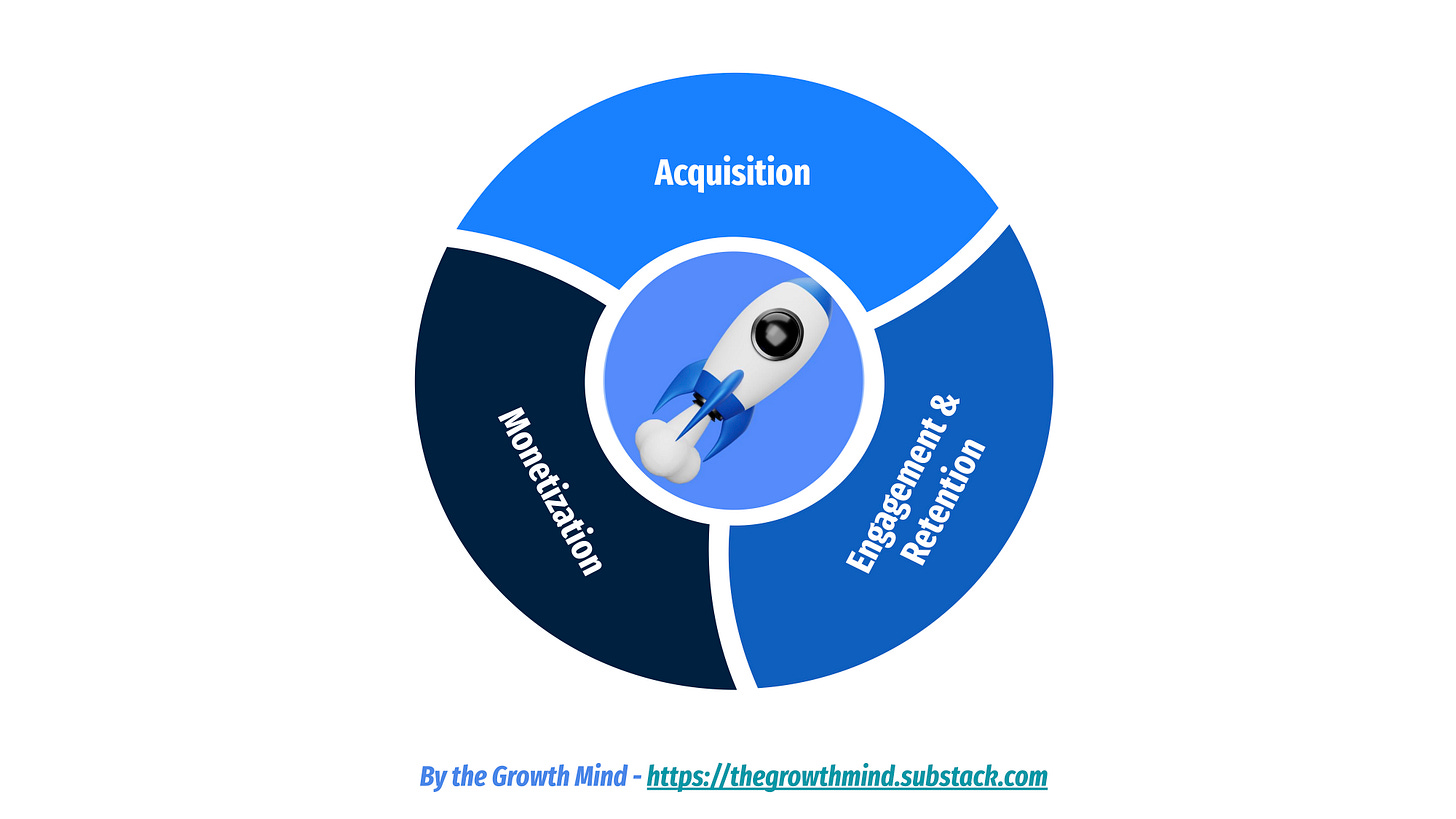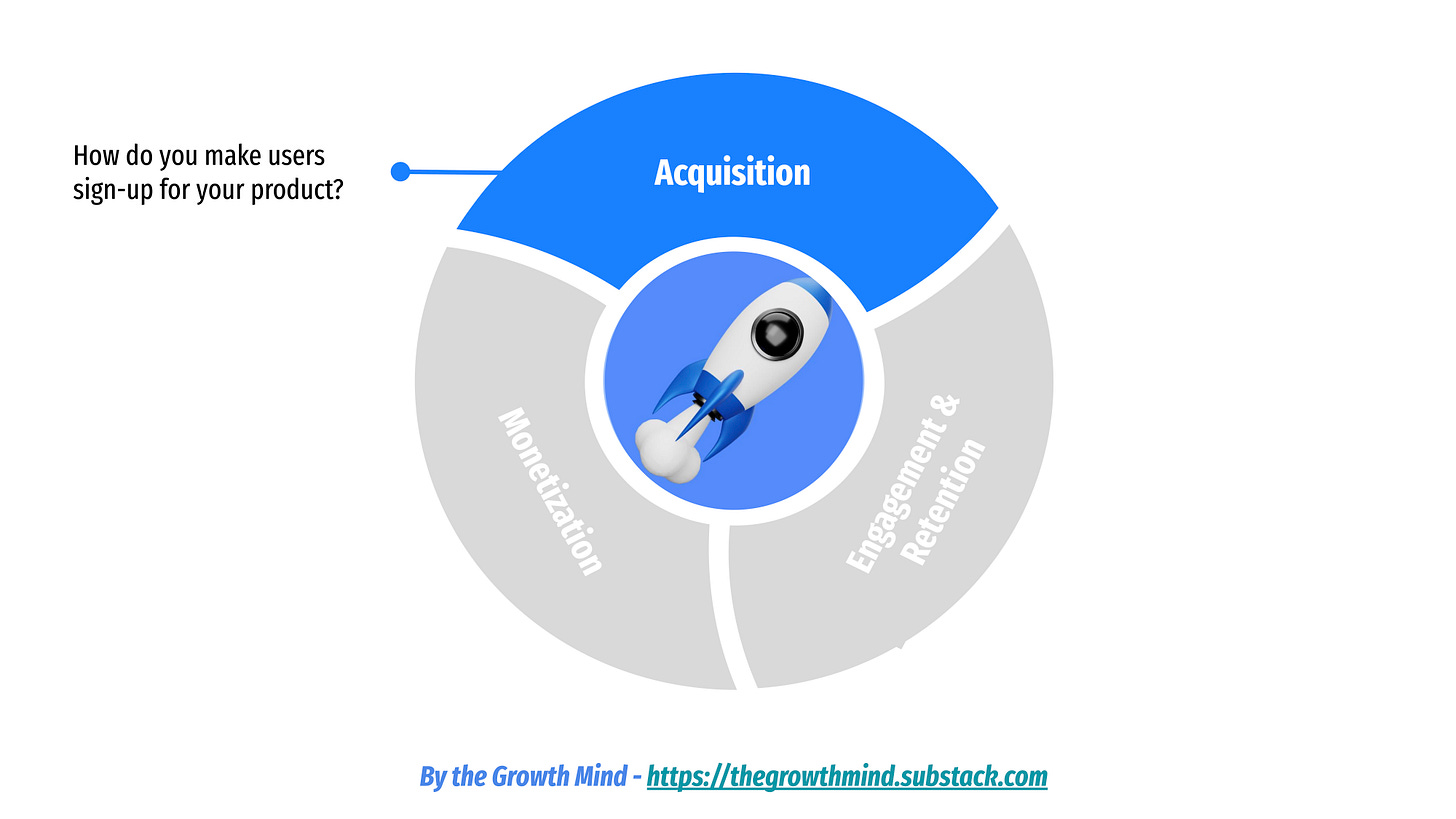Acquisition - Growth Metrics Series (1/3)
Understand the key acquisition metrics to drive growth
👋 Hi there, it’s Pierre-Jean. Welcome to this new edition of The Growth Mind!
Every 2 weeks, I share Growth strategies inspired by the world’s leading scale-ups.
Today, I’m excited to share with you the first edition of the “Growth Metrics” Series 🍿
If you’re not new to The Growth Mind, you know that you usually receive one email every 2 weeks from me.
But this week will be slightly different 👀
During 3 days, you’ll receive an email each day about “Growth Metrics”:
Day 1: Acquisition Metrics
Day 2: Engagement and Retention Metrics
Day 3: Monetization Metrics
So today we kick off the series with a post about acquisition metrics.
⏱️ Reading time = 3 minutes
Growth metrics can be divided into 3 main stages:
🎯 Acquisition: How do you make users sign-up for your product? It’s all about feeding your top of the funnel and converting visitors into leads.
♻️ Engagement and retention: Do people use your product deeply, over time? Here we want to convert leads into active users who strongly engage with our product over time.
💸 Monetization: How do you generate revenue with your users? Monetizing well leads to generating revenue. We want to look at how we perform at making revenue out of our existing users.
For each stage, it’s crucial to monitor the right metrics to see where you perform and where you can look for improvements.
Improving each metric individually can lead to a strong impact on your revenue.
Let’s start the “Growth Metrics” series with acquisition metrics 🚀
In the acquisition phase, your main goal is to make users discover your product and sign-up/book a demo. This is the stage where you feed your top of the funnel.
From getting people to see your ads and landing them on your website, to converting them into sign-ups and monitoring the costs, the playground of acquisition is vast.
Website/app store metrics:
Website/store page visits: The number of users visiting your website or app store page.
New vs returning visitors: The proportion of new users compared to users who are revisiting. It gives you an indication if you’re refreshing your pool of visitors.
Bounce rate: The percentage of users who visit your website and leave without viewing other pages/after a few seconds. A high bounce rate indicates that your page has not hooked viewers.
CTR (Click-Through Rate): The ratio of users who click on a specific link (generally a call to action) to the number of total users who view a page.
Time on page: The average time a user spends viewing a single page. It should not necessarily always need to be long, but a too-short time on a page indicates users are not interested in your content.
Sign-up metrics:
Sign-ups: The number of new users who sign up for your product or service. This is probably the most critical metric to monitor for acquisition, as it is your end goal.
Conversion rate: The percentage of users who sign-up out of all users.
Time to convert: The average time it takes a user to make a desired action after their first visit. The faster you convert, the better it is.
Financial metrics:
CAC (Customer Acquisition Cost): The cost to acquire a new customer. Your CAC should ideally always be lower than your LTV. But depending on your strategy, having a high CAC during a period can be acceptable (eg. in a winner-takes-all market).
LTV/CAC (Customer Lifetime Value to Customer Acquisition Cost): A ratio that compares the lifetime value of a customer to the cost of acquiring that customer. This metric is super important to see if you’re building a sustainable acquisition engine. We generally recommend having a 3/1 ratio, but it depends on your sector.
Payback period: The time needed to earn back what you paid to acquire a customer. A short payback period allows you to quickly reinvest money into acquisition, meaning you’re going to improve the velocity of your paid acquisition loop.
ROAS (Return on ad spend): The return on investment of your ads. For example, if you spend 1000$ on an advertising campaign and it leads to 5000$ in revenue, the ROAS is 5. This means you get $5 for each $1 you spend on paid ads. This a famous metric in e-commerce.
Growth rate evolution:
Month-over-month acquisition growth: A good MoM acquisition growth reflects your scaling potential, your “traction”. A flat rate can be acceptable if you’re running a healthy profitable business not designed to become a scale-up, but not if your goal is to build a unicorn.
How to analyze your Acquisition Metrics? 📊
When monitoring acquisition, it’s really important to break down metrics per acquisition channel.
Without doing it, you’ll only have a partial comprehension of how you acquire users.
Each channel may have a different cost, conversion rate, and user quality.
Doing the breakdown of metrics per channel will help you to understand if:
A channel brings a low or large volume (visitors, sign-ups).
If this volume is converting well (conversion rate, time to convert).
How much it costs you to acquire a user through this specific channel (CAC, payback period).
By looking at those 3 criterias, you could either choose to keep a channel, kill it or scale it. And improve your overall acquisition metrics.
Consider performing cohort analysis and building funnels to understand how users from each channel, and even campaigns, behave.
For example, users acquired through a discount campaign, which is an aggressive strategy, might behave totally differently from users acquired through your regular campaigns.
→ To have a clear overview of the conversion between each step of the acquisition journey, build simple funnels with the main steps your users should go through.
Eg.: Website visit → Click on CTA → Start sign-up form → Submit sign-up form
That’s all for Acquisition Metrics! Hope you liked this first article.
Tomorrow, we’ll deep dive into Engagement & Retention Metrics ♻️
To share detailed feedback, feel free to:
Reply directly to this email
Shoot me a message on LinkedIn
I read everything 🫡







📈📈
🙌